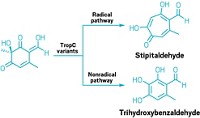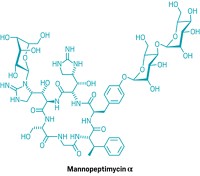Advertisement
Grab your lab coat. Let's get started
Welcome!
Welcome!
Create an account below to get 6 C&EN articles per month, receive newsletters and more - all free.
It seems this is your first time logging in online. Please enter the following information to continue.
As an ACS member you automatically get access to this site. All we need is few more details to create your reading experience.
Not you? Sign in with a different account.
Not you? Sign in with a different account.
ERROR 1
ERROR 1
ERROR 2
ERROR 2
ERROR 2
ERROR 2
ERROR 2
Password and Confirm password must match.
If you have an ACS member number, please enter it here so we can link this account to your membership. (optional)
ERROR 2
ACS values your privacy. By submitting your information, you are gaining access to C&EN and subscribing to our weekly newsletter. We use the information you provide to make your reading experience better, and we will never sell your data to third party members.
Catalysis
Glionitrins synthesized for the first time
Asymmetric organocatalysis forges tricky carbon-sulfur bond in antibacterial and anticancer molecules
by Mark Peplow, special to C&EN
December 15, 2021
| A version of this story appeared in
Volume 99, Issue 45

The newly reported total synthesis of (–)-glionitrin A and B—a pair of molecules discovered in water from an abandoned mine that have antibacterial and anticancer properties—could open up fresh routes to a whole family of biologically active molecules (J. Am. Chem. Soc. 2021, DOI: 10.1021/jacs.1c10364).
The water sample, collected at a South Korean coal mine, was highly contaminated with heavy metals and sulfuric acid (J. Nat. Prod. 2009, DOI: 10.1021/np800606e). But it also contained a fungus that made the glionitrins, possibly as a natural antibiotic to fight a bacterium found in the same sample.
(–)-Glionitrin A has antibacterial and antitumor activity, whereas the closely related (–)-glionitrin B can hamper the migration of cancer cells. But it’s difficult to make the glionitrins by fermentation, and researchers have struggled to produce enough of the molecules to study their biological activities.
The molecules also posed a tough challenge for synthetic chemists. Both glionitrins include a pretty crowded ring—a dithiodiketopiperazine—that contains two asymmetric carbon atoms bonded to sulfur atoms. In (–)-glionitrin A, these sulfurs form a bridge across the ring. “They’re beautiful, but from a synthetic perspective it’s not obvious how you would create this motif,” says Daniel Strand of Lund University, who led the synthesis.
His team found that conventional methods to form carbon-sulfur bonds tended to disrupt other parts of the incipient glionitrin. The researchers pursued the synthesis for 4 years, and most of that time was spent developing a new reaction to form that bond. The reaction relies on a chiral N-thiosuccinimide reagent and an asymmetric organocatalyst, and it works at gram scale and at room temperature in about 15 min.
With the first C–S bond in place, it was relatively straightforward to use other reactions to position the second C–S bond and then connect the sulfurs together. The entire eight-step synthesis made (–)-glionitrin A with an overall yield of 15%, and its sulfur bridge was easily broken to generate (–)-glionitrin B.
“It’s great work,” says Olivier Baudoin of the University of Basel, who has also worked on dithiodiketopiperazine natural products (J. Am. Chem. Soc. 2019, DOI: 10.1021/jacs.9b09359). “These are deceptively simple small molecules that are extremely difficult to make, and this study will allow further investigation of their biological properties.”
Strand’s team discovered that the structure of (–)-glionitrin A is actually the mirror image of what was originally reported and confirmed this by synthesizing the opposite enantiomer using the same method. “I was amazed that they were also able to correct the absolute configuration of the molecules,” Baudoin says. That should make it easier to explore differences in the biological properties of the two enantiomers, he says.
The researchers also used their new reaction to produce six other molecules containing dithiodiketopiperazine rings. These structures are the basis of various natural products, and Strand hopes that the method could help to synthesize a wide range of bioactive molecules in this family.





Join the conversation
Contact the reporter
Submit a Letter to the Editor for publication
Engage with us on Twitter